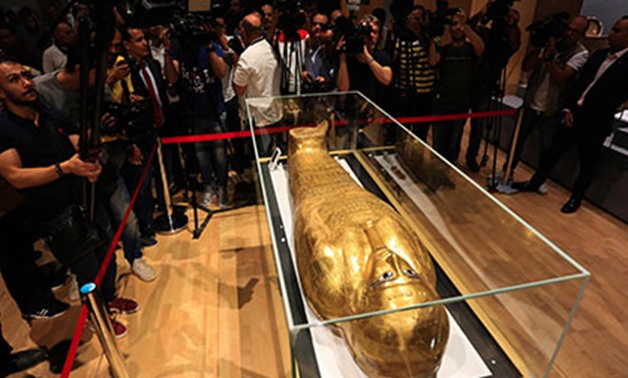CAIRO – 29 March 2022: Roben Dib, a fugitive merchant, was arrested by the American and French authorities while in Paris.
Dib played a central role in selling looted antiquities to international museums, and he was the main player in the illegal smuggling of the 2,100 year-old Egyptian sarcophagus of Nedjemankh and its sale to the Metropolitan Museum.
According to official sources, Paris judge Jean-Michel Gentile indicted Dib on charges of mass fraud and money laundering.
Dib is currently detained after his arrest last week. It was revealed that he was transferred from Hamburg, on the basis of a European arrest warrant, according to the Art News Paper website.
It is reported that in 2020, the French expert Christophe Kunicki and Richard Semper were arrested. They were charged with widespread trafficking of looted artifacts, and were placed under house arrest in southwestern France.
Kunicki sold a golden sarcophagus in 2017 for €3.5 million. In 2019, the museum apologized and returned it to Egypt. The story goes back to the theft of the golden coffin from Egypt in 2011 when the country was in a state of political and social turmoil after the events of January 25. The Metropolitan Museum in New York purchased the coffin from an art dealer in Paris in July 2017 for about $4 million, from one of the antiquities dealers who held an exit permit for the piece issued in Egypt and dating back to 1971.
At the time, Egypt’s Minister of Tourism and Antiquities Khaled el-Enani said that this was done through the Ministry of Foreign Affairs in cooperation with the Recovered Antiquities Department and the American Antiquities Unit, as the latter requested to verify the authenticity of the coffin’s export document after its display at the Metropolitan Museum.
Enani stated that after the Egyptian Antiquities Committee reviewed the document, it was confirmed that the documents were forged, as they contained an eagle seal at a time when this seal was not approved. The piece in the document bore a number and name that belonged to an entirely different piece.
During the investigations carried out by the Prosecutor’s Office of the City of Manhattan in New York, which lasted for more than 20 months, the General Administration of Recovered Antiquities of the Ministry of Antiquities, in coordination with the Egyptian Ministry of Foreign Affairs, provided all the evidence that proves beyond a reasonable doubt that the alleged permission for the transfer of the piece in 1971 was forged and that Egypt did not issue a permit for this piece at all. The law before 1983 allowed the issuance of permits for the exit of some parts outside Egypt.
Based on the documents sent by the Ministry of Antiquities, the investigations Office concluded that Egypt was entitled to recover this archaeological sarcophagus, and that the export permit for it was forged. The Metropolitan Museum was subjected to a forgery when it was purchased.
In this context, the director general of the Metropolitan Museum sent a letter to apologize to the Ministry of Antiquities, the government and the Egyptian people for the incident, assuring that the museum had already taken all measures to return the piece to its mother country, Egypt.
The Ministry of Antiquities displayed the golden sarcophagus of the Pharaonic priest, Nedjemankh, upon its retrieval from the United States in 2019.

The golden sarcophagus of Nedjemankh was displayed in the attendance of Minister of Antiquities Khaled el-Enani, Secretary General of the Supreme Council of Antiquities Mostafa Waziri and a number of foreign ambassadors and representatives of archaeological missions in Egypt.
The Egyptian diplomatic efforts succeeded in recovering the golden sarcophagus of the Pharaonic priest, Nedjemankh, as part of the growing international efforts to combat the black market of antiquities and the exceptional efforts of the Egyptian state to retrieve its stolen artifacts.
The golden sarcophagus is made in the shape of a mummy and is 6 feet (2 meters) long. It is subtly made of wood and metal. The sarcophagus is covered with gold plates, elaborately decorated with hieroglyphic scenes and texts aimed at guiding the priest on his journey to eternal life.
According to CNN reports, gold found in the coffin symbolizes the priest's relationship with the Egyptian gods, where it was widely believed that the gods were made of precious metal.
“This is not only for Egyptians but also for our common human heritage as we all share the same values and are parts of the same international family,” Minister of Foreign Affairs Sameh Shoukry said at the repatriation ceremony.
Comments
Leave a Comment